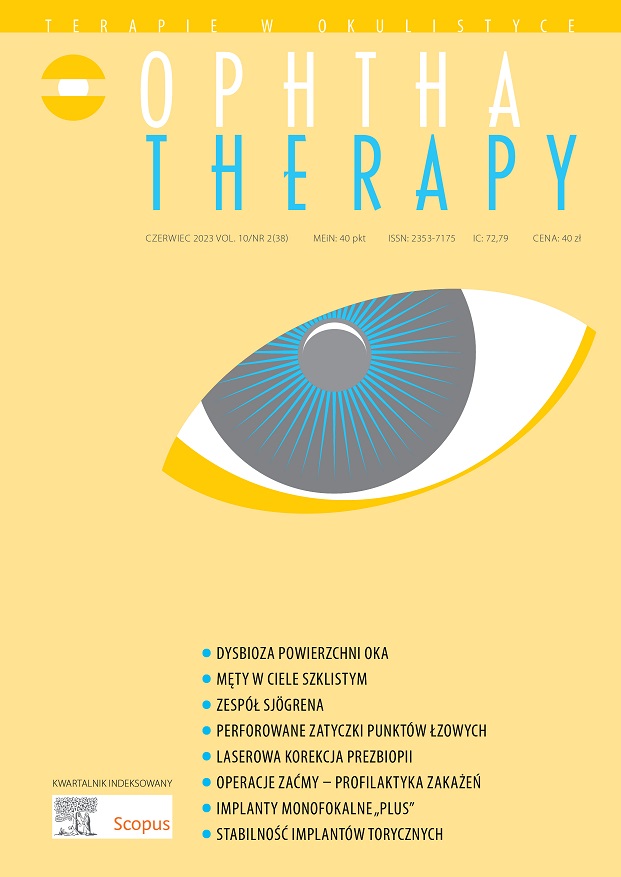The use of modern monofocal „plus” lenses in the cataract surgery Case report
Main Article Content
Abstract
The use of monofocal „plus” lenses allows for greater independence from spectacle correction than monofocal lenses. Studies show good visual function of patients at almost all distances and minimal presence of undesirable optical artifacts in the postoperative refraction setting of bilateral emmetropia and monovision. The paper presents the use of monofocal „plus” lenses in the monovision setting.
Downloads
Article Details

This work is licensed under a Creative Commons Attribution-NonCommercial-NoDerivatives 4.0 International License.
Copyright: © Medical Education sp. z o.o. License allowing third parties to copy and redistribute the material in any medium or format and to remix, transform, and build upon the material, provided the original work is properly cited and states its license.
Address reprint requests to: Medical Education, Marcin Kuźma (marcin.kuzma@mededu.pl)
References
2. Asbell PA, Dualan I, Mindel J et al. Age-related cataract. Lancet. 2005; 365(9459): 599-609.
3. Marcos S, Barbero S, Jiménez-Alfaro I. Optical quality and depth-of-field of eyes implanted with spherical and aspheric intraocular lenses. J Refract Surg. 2005; 21(3): 223-35.
4. Schmidt D, Grzybowski A. Fukala (1847-1911) and the early history of clear lens operations in high myopia. Saudi J Ophthalmol. 2013; 27: 41-6.
5. Kaweri L, Wavikar C, James E et al. Review of current status of refractive lens exchange and role of dysfunctional lens index as its new indication. Indian J Ophthalmol. 2020; 12: 2797-803.
6. Black S. A clinical assessment of visual performance of combining the TECNIS((R)) Symfony Extended Range of Vision IOL (ZXR00) with the +3.25 D TECNIS Multifocal 1-piece IOL (ZLB00) in subjects undergoing bilateral cataract extraction. Clin Ophthalmol. 2018; 12: 2129-36.
7. Venter JA, Pelouskova M, Collins BM et al. Visual outcomes and patient satisfaction in 9366 eyes using a refractive segmented multifocal intraocular lens. J Cataract Refract Surg. 2013; 39(10): 1477-84.
8. Cochener B, Lafuma A, Khoshnood B et al. Comparison of outcomes with multifocal intraocular lenses: A meta-analysis. Clin Ophthalmol. 2011; 5: 45.
9. Auffarth G. Enhanced monofocals: minimising dysphotopsia and maximising visual quality. Eurotimes. 2021; June(Suppl): 3-4.
10. Salerno LC, Tiveron MC Jr, Alio JL. Multifocal intraocular lenses: Types, outcomes, complications and how to solve them. Taiwan J Ophthalmol. 2017; 4(7): 179-84.
11. Hu JQ, Sarkar R, Sella R et al. Cost-effectiveness analysis of multifocal intraocular lenses compared to monofocal intraocular lenses in cataract surgery. Am J Ophthalmol. 2019; 208: 305-12.
12. Braga-Mele R, Chang D, Dewey S et al. Multifocal intraocular lenses: relative indications and contraindications for implantation. J Cataract Refract Surg. 2014; 40: 313-22.
13. de Vries NE, Webers CA, Touwslager WR et al. Dissatisfaction after implantation of multifocal intraocular lenses. J Cataract Refract Surg. 2011; 37: 859-65.
14. Al-Sayyari TM, Fawzy SM, Al-Saleh AA. Corneal spherical aberration in Saudi population. Saudi J Ophthalmol. 2014; 28(3): 207-13.
15. Boerner CF, Thrasher BH. Results of monovision correction in bilateral pseudophakes. J Am Intraocul Implant Soc. 1984; 10: 49-50.
16. Zhang F, Sugar A, Jacobsen G et al. Visual function and spectacle independence after cataract surgery: Bilateral diffractive multifocal intraocular lenses versus monovision pseudophakia. J Cataract Refract Surg. 2011; 37: 853-8.
17. Labiris G, Giarmoukakis A, Patsiamanidi M et al. Mini-monovision versus multifocal intraocular lens implantation. J Cataract Refract Surg. 2015; 41: 53-7.
18. Chen M, Atebara NH. A comparison of a monofocal Acrysoft IOL using the “blended monovision” formula with the multifocal array IOL for glasses independence after cataract surgery. Ann Ophthalmol. 2007; 39: 237-40.
19. Wilkins MR, Allan BD, Rubin GS et al.; Moorfields IOL Study Group. Randomized trial of multifocal intraocular lenses versus monovision after bilateral cataract surgery. Ophthalmology. 2013; 120(12): 2449-55.
20. Mahrous A, Ciralsky JB, Lai EC. Revisiting monovision for presbyopia. Curr Opin Ophthalmol. 2018; 29: 313-17.
21. Evans BJ. Monovision: A review. Ophthalmic Physiol Opt. 2007; 27: 417-39.
22. MacRae S, Holladay JT, Glasser A et al. Special report: American Academy of Ophthalmology Task Force consensus statement for extended depth of focus intraocular lenses. Ophthalmology. 2017; 124: 139-41.
23. Bellucci R, Cargnoni M, Bellucci C. Clinical and aberrometric evaluation of a new extended depth-of-focus intraocular lens based on spherical aberration. J Cataract Refract Surg. 2019; 45: 919-26.
24. Ribeiro F, Cochener B, Kohnen T et al. Definition and clinical relevance of the concept of functional vision in cataract surgery ESCRS Position Statement on Intermediate Vision: ESCRS Functional Vision Working Group. J Cataract Refract Surg. 2020; 46(suppl 1): S1-S3.
25. Łabuz G, Son HS, Naujokaitis T et al. Laboratory Investigation of Preclinical Visual-Quality Metrics and Halo-Size in Enhanced Monofocal Intraocular Lenses. Ophthalmol Ther. 2021; 10(4): 1093-104.

